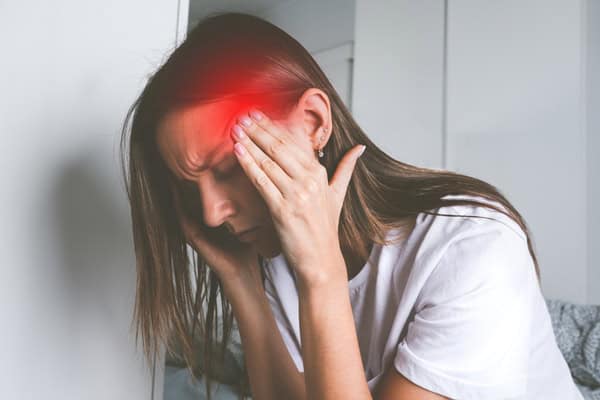Migraines are a recurring type of headache. They cause moderate to severe pain that is throbbing or pulsing. The pain is often on one side of your head. You may also have other symptoms, such as nausea and weakness. You may be sensitive to light and sound.
Signs and symptoms:
There are four different phases of migraines. You may not always go through every phase each time you have a migraine.
- Prodome. This phase starts up to 24 hours before you get the migraine. You have early signs and symptoms, such as food cravings, unexplained mood changes, uncontrollable yawning, fluid retention, and increased urination.
- Aura. You might see flashing or bright lights or zig-zag lines or you may have muscle weakness.
- Headache. A migraine usually starts gradually and then becomes more severe. It typically causes throbbing or pulsing pain, which is often on one side of your head. But sometimes you can have a migraine without a headache.
- Postdrome (following the headache). You may feel exhausted, weak, and confused after a migraine. This can last up to a day.
When to see the doctor?
- Even if you have a history of headaches, see your doctor if the pattern changes or your headaches suddenly feel different.
- See your doctor immediately or go to the emergency room if you have any of the following signs and symptoms, which could indicate a more serious medical problem:
- An abrupt, severe headache like a thunderclap
- Headache with fever, stiff neck, confusion, seizures, double vision, numbness or weakness in any part of the body, which could be a sign of a stroke
- Headache after a head injury
- A chronic headache that is worse after coughing, exertion, straining or a sudden movement
- New headache pain after age 50.
میگرین (آدھے سر کا درد یا درشقيقہ)
میگرین ایک بار بار ہونے والا سر درد ہے۔ اسکی وجہ سے کم نوعیت کے درد سے شدید تکلیف جو کہ دھڑکتی ہوئی ہو، محسوس ہو سکتی ہے۔ زیادہ تر، یہ درد سر ک ایک حصے کی طرف سے ہوتا ہے۔ آپکو دوسری علامات بھی ہی سکتی ہیں، جیسے کہ متلی اور کمزوری۔ آپ روشنی اور آواز سے بھی حساسیت محسوس کر سکتے ہیں
میگرین کی کیا علامات ہیں؟
میگرین کے چار مختلف مراحل ہوتے ہیں۔ ایسا بھی ہو سکتا ہے کہ جب بھی میگرین ہو آپ ان چاروں مراحل سے نہ گزریں۔
۱. پروڈوم: یہ مرحلہ میگرین شروع ہونے کے ۲۴ گھنٹے پہلے سے شروع ہو سکتا ہے۔ ابتدائی علامات میں مخصوص کھانے کی خواہش، غیر موزوں مزاج میں ردوبدل، زیادہ جمائیاں آنا، سیال کی برقراری اور پیشاب میں اضافہ شامل ہیں۔
۲. اورا: ہو سکتا ہے کہ اس مرحلے میں آپکو چمکتی یا بھڑکتی ہوئی روشنی محسوس ہو، یا زک زیک لائنز دکھائی دیں یا پٹھوں میں کمزوری ہو۔
۳. سر درد: سر کا درد عموماً آہستہ آہستہ شروع ہوکر شدّت اختیار کر جاتا ہے۔ عام طور پر یہ دھڑکنے یہ چھڑکنے جیسا درد پیدا کرتا ہے، جو سر کی ایک طرف ہوتا ہے۔ لیکن ایسا بھی ممکن ہے کہ میگرین میں سیر کا درد نہ ہو۔
۴. پوسٹ ڈروم (سر کے درد کے بعد) : میگرین کے ایک دن بعد تک
آپ کو تھکاوٹ، کمزوری اور اُلجھن محسوس ہو سکتی ہے۔
ڈاکٹر سے کب ملیں؟
اگر آپ کے سر میں درد ہوتا ہے تو درد کے انداز کی انداز میں تبدیلی یا سر درد کی صورت میں اپنے احساس میں تبدیلی محسوس کرنے پر ڈاکٹر سے رجوع کریں۔
مندجہ ذیل علامات کی صورت میں ڈاکٹر سے فوری رابطہ کریں یا ہنگامی صورت میں ہسپتال جائیں:
گرج چمک جیسا اچانک اٹھنے والا سر درد ہو۔
ایسا سردرد کہ جس میں بخار، اکڑی ہو گردن، اُلجھن، دورے پڑیں، ہر چیز دو نظر آئے، جسم کہ کسی بھی حصے میں سنسناہٹ یا کمزوری جو کہ فالج کی علامت ہو سکتی ہے ۔
سر پر چھوٹ لگنے کہ بعد اٹھنے والا درد۔
دائمی سر درد جو کے کھانسی، تھکاوٹ، تناؤ اور حرکت سے بڑھ جائے ۔
۵ سال کی عمر کہ بعد اٹھنے والا نیا سر درد
Doctors to consult (Neurologist):
Dr Gulab Shah Kakar, Dr Samad Panezai, Dr Syed Ahsan
Note: Click the Doctor's name to make an appointment.
Reference:
https://medlineplus.gov/migraine.html
https://www.bettersafercare.vic.gov.au/clinical-guidance/emergency/migraine
https://www.mayoclinic.org/diseases-conditions/migraine-headache/symptoms-causes/syc-20360201
https://patient.info/brain-nerves/migraine-leaflet

